TUMBLE DRYER BUYING GUIDE
FACTORS TO CONSIDER WHEN PURCHASING A NEW TUMBLE DRYER
|
TYPE
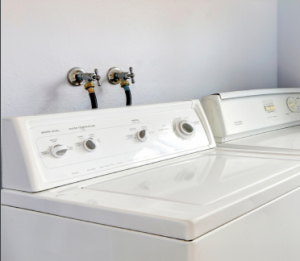
Choosing which type of tumble dryer to buy can be tricky when there are so many brands, but you only really have two things to think about in terms of the way the machine loads.
FRONT LOADING
A front loading tumble dryer is traditionally the most popular model here in the UK, allowing it to be situated under a countertop on stacked onto a unit.
TOP LOADING
A more classic design which will be more familiar to Americans, the top loading tumble dryer is perfect if you’re placing the dryer in another room or into a recess
without a counter top.
As well as looking at the way the appliance is loaded you should think about what type of door you want to have on your tumble dryer. There are several different ways
you can go, the front loading machines particularly have a few options including doors which look similar to circular washing machine doors and square fronted panel doors. Top loading machines generally have a standard flat top lid which you lift to load.
It all depends on your personal preference and where you intend to install the appliance.
VENTED OR CONDENSER
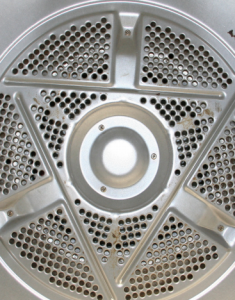
Tumble dryers work by using a flow of hot air in the drum, the drum turns to toss the clothes and evenly distribute the heat therein. You can set a timer on most tumble
dryers for the length of the process as you see fit while other might have a sensor which will limit the time of the process.
One major decision you will have to make is choosing between a vented or condenser tumble dryer. The two perform the same job but get rid of the hot air and
moisture from your clothes in a different way.
VENTED TUMBLE DRYERS
For the vented appliance the heated air carrying the moisture is pumped out of the unit altogether. This kind of appliance will feature a hose – usually around 2 metres
worth – which will look much like the vent used in an extractor hood.
You’ll need to arrange for the pipe to lead outside or risk pumping the warm air into your home. This can be done either by hanging it out of a nearby window or by having
a permanent route out through a wall.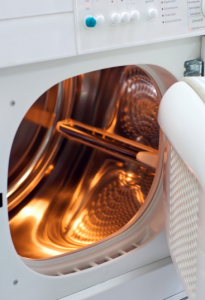
CONDENSER TUMBLE DRYERS
The same process is involved for condenser tumble dryers as for vented ones; the drum tumbles the clothes and the hot air is is blown through to dry the clothes.
The difference comes with how it deals with all the air and moisture internally. Using a large plastic container fitted into the unit, the appliance collects the moisture and drains it off to the container.
While this gives the appliance independence you will have to manually empty the container by removing it and pouring the moisture away. Some people have their appliance plumbed in to avoid this process and to aid drainage efficiency.
Condenser units are the more expensive of the two but clearly look a lot neater and don’t require additional works to be installed. Vented units on the other hand don’t seem to be making much progress in terms of developments with manufacturers focusing on condensers.
HEAT PUMP TECHNOLOGY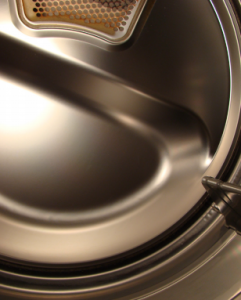
Given how long tumble dryers have been around it’s surprising that new technology wasn’t introduced sooner. In an effort to help people reduce their energy consumption and costs – with many people unable to afford the running costs of a tumble dryer – heat pump technology has been integrated into tumble dryers.
HOW IT WORKS
- Firstly, the heated, dry air is sent into the drum to begin the drying process
- The heated air picks up the moisture and is taken out of the drum and sent towards the evaporator
- Once the moisture has been taken out at the coolant phase the left over heated air is used to turn the coolant into a gas
- The gas is passed into a compressor which causes it to rise and is passed on to the condenser to aid in the heating process
- The gas then turns back into a liquid and is fed back into the coolant phase to help with evaporation
Using a heat pump aided tumble dryer could see you use 50% less energy in comparison to standard models. By recycling the heat of your tumble dryer you’ll save
money and reduce your carbon footprint in the long run, however, you may end up laying out more money on this technology initially.
WASHER DRYERS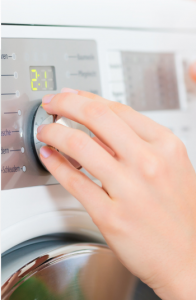
Having been around for quite some time now – since the 1950s in fact – washer dryers are nothing new and are pretty self explanatory. They’ve been developed over decades to bring efficiency to doing the laundry in a busy household.
ADVANTAGES
One of the biggest advantages for washer dryers is the fact that you save on space. One appliance takes up far less room than two, meaning you maximise the space in your
kitchen or utility. This is great if you have a small household and need to get through your laundry quickly.
Washer dryers still come with the same features combined from each appliance, but the more you pay the more features and functions you will get. If there is a particular kind of wash you need then keep an eye out for it on the features list.
DISADVANTAGES
With a smaller drum size you’ll find there is a very specific drawback to having a washer dryer. You simply won’t be able to fit as many clothes in your drum and therefore will find yourself doing more loads which could slow down your progress.
If you have a large household then you might find yourself wanting to surge your way through your washing only to be scuppered by the backlog being broken into small
loads. It’s important to think about the practicalities of a washer dryer and whether it suits your family and their habits.
ENERGY EFFICIENCY
Tumble dryers come with an energy efficiency rating just like other appliances. Based on their energy consumption and drying performance they are awarded a grade between A and G – A being the best, most efficient rating. Trading Standards monitor manufacturers who conduct tests themselves to gauge efficiency.
It’s common knowledge that a tumble dryer is more costly to run, but with a heat pump condenser you might be able to bring the costs down. Similarly, try to manage your loads and only use the tumble dryer when you really need it, such as in winter when it’s hard to hang washing out to dry.
You can also get savvy with your settings to lower your energy bills. For example, if you live in an area with cheaper tariffs at night you could delay your dryer to come on and take advantage of this.
THINK ABOUT… TOP LOADERS
If you should choose to place your tumble dryer in a less conventional room then you might want to consider the top loading version of this appliance. It saves you stopping down to load it and means it can be placed in a corner and isn’t hindered by items or doorways nearby.
FITTING
Depending on what type of tumble dryer you decide to purchase, your fitting and installation needs will be different.
INTEGRATED
Any integrated unit will fit seamlessly with your kitchen or utility room and can be hidden behind matching cabinet doors. However, if repairs are required further down
the line you may face damage to your kitchen fittings.
FREESTANDING
A freestanding tumble dryer is possibly the most flexible option as you can place it under any countertop if it is front loading. Even if it’s top loading you can have the option of moving the unit around and you’ll get easy access should any repairs be needed.
Unlike your washing machine, which strictly needs to be in close proximity to your water supply valve, your tumble dryer can be placed anywhere in the house you choose. But remember, a vented unit needs somewhere for the outlet hose to get outside – either through the wall or out of the window.
Some people like to have their washing machine and tumble dryer side by side but this isn’t totally necessary. You can choose to install your tumble dryer in the garage or even the cellar if it’s adequately converted. However, you will always require an electricity outlet to plug the appliance in.
SIZE AND MEASUREMENTS

Much like with their washing counterparts, tumble dryers can come in variety of sizes. You’ll usually see this detailed in kilograms and as a rule of thumb you should view a kilogram as equally one average outfit of trousers, socks, underwear and a top.
Ranging from the mini sized 3kg drum up to around 9kg, you can find the right size tumble dryer for your home, but remember not to overload the drum with a full wash as this will mean you need to give the clothes longer to dry and they will come out more crumpled. A stainless steel drum is also preferable as it lowers the risk of clothes snagging whilst being tumbled.
The other reason to consider the size of your appliance is for choosing where you’ll locate it. Take measurements of the space in which you want to place your tumble dryer, including width, height and depth – this is especially key if your new appliance is replacing an old one under a counter top.
THINK ABOUT… RECYCLING
If your new unit does replace your old one then have a look at whether the delivery company will take away the old unit and recycle it. Having two large appliances in your home with the same purpose is pointless and makes it tricky to install the new one. You may have to pay extra but it saves you the hassle and helps the environment.
|
